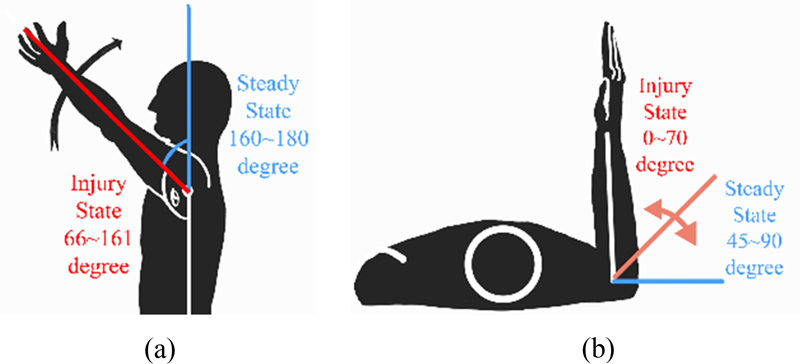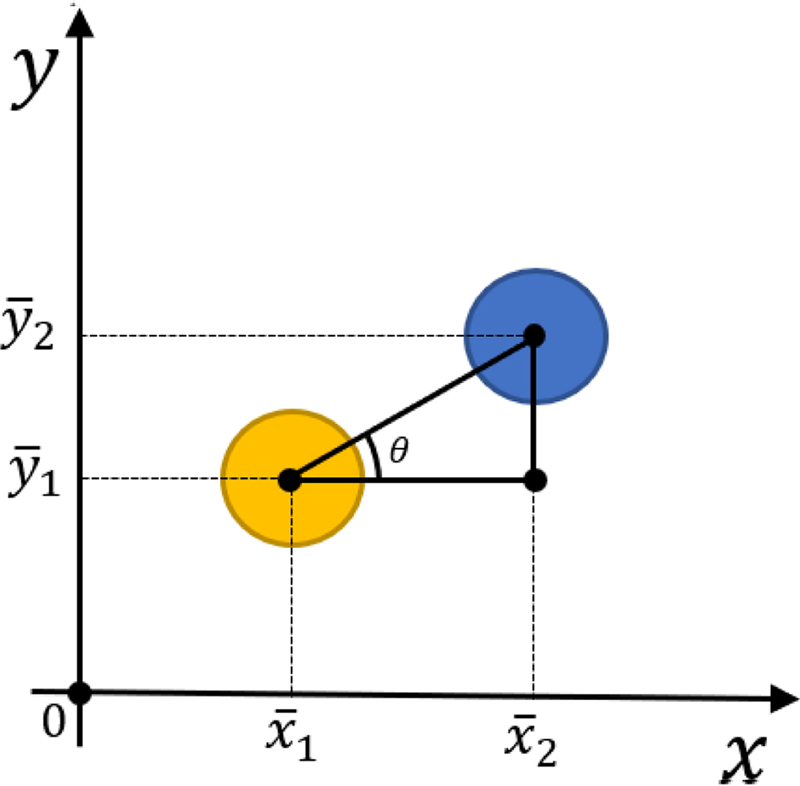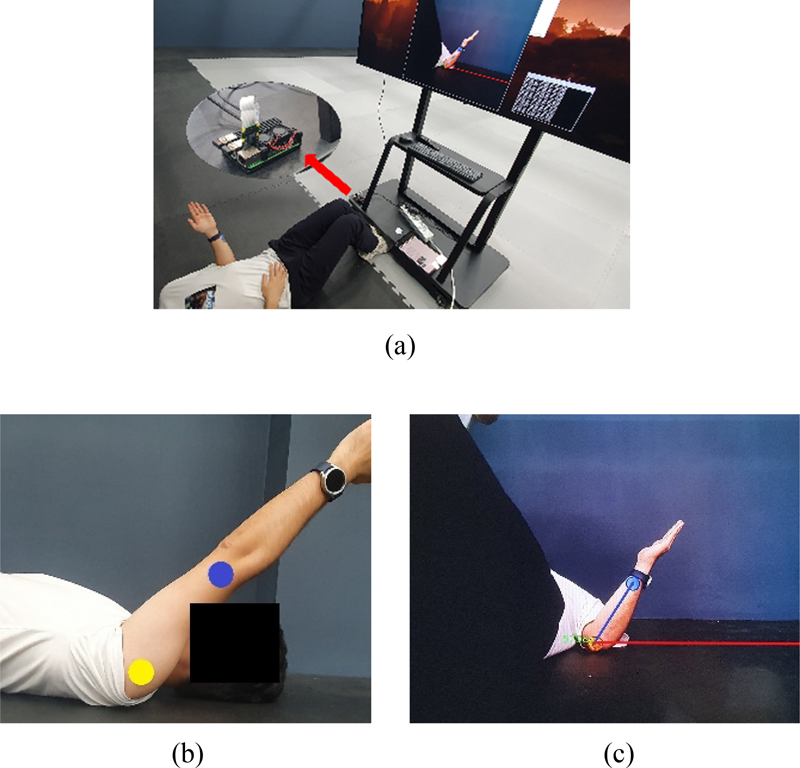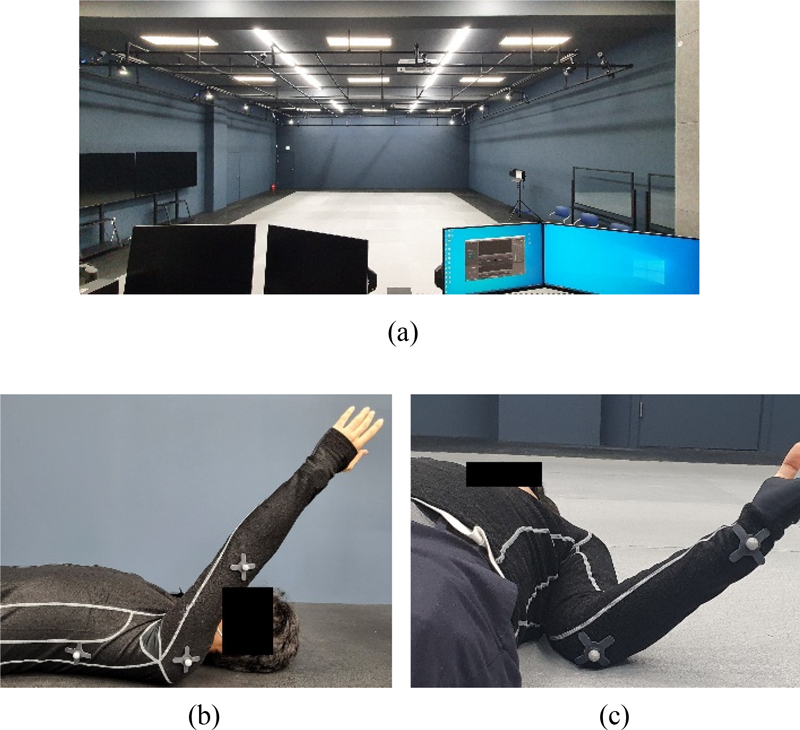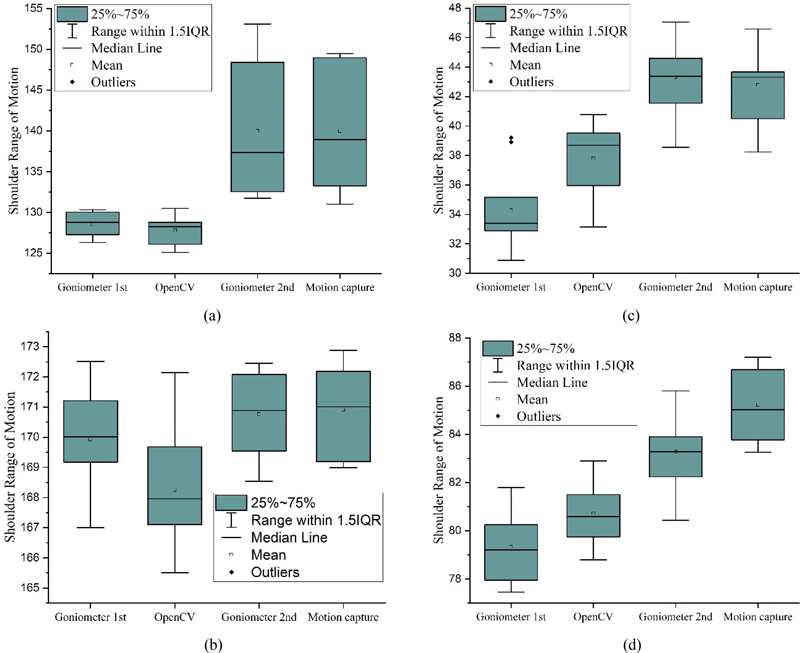
OpenCV와 모션 캡처를 이용한 어깨관절 가동범위 측정 신뢰도 검증
1강원대학교 대학원 스마트헬스과학기술융합학과2강원대학교 대학원 기계융합공학과
3강원대학교 의과대학 재활의학교실

2Department of Mechanical Convergence Engineering, Graduate School, Kangwon National University
3Department of Rehabilitation Medicine, School of Medicine, Kangwon National University
Copyright © The Korean Society for Precision Engineering
This is an Open-Access article distributed under the terms of the Creative Commons Attribution Non-Commercial License (http://creativecommons.org/licenses/by-nc/3.0) which permits unrestricted non-commercial use, distribution, and reproduction in any medium, provided the original work is properly cited.
Abstract
As the population ages, the concept of active seniors has been emerging recently. Among various body parts that are cared for by an active elderly, the shoulder has a unique exercise structure. Therefore, the incidence of shoulder injuries might be high. In the case of a shoulder disease, the method of measuring the movement angle of the shoulder is mainly used. To measure the movement angle of a shoulder accurately, a goniometer is used. In addition, we suggested self-diagnosis, believing that if shoulder disease could be detected early through self-diagnosis, rapid treatment will be possible. This paper measured and compared shoulder angles with the goniometer, OpenCV, and motion capture systems to determine measurement errors between them. Through experimental results of this paper, the possibility of self-diagnosis with precise measurement of the movement angle of a shoulder oneself with a goniometer was confirmed even if the expert could not measure the shoulder angle.
Keywords:
OpenCV, Motion capture, Rotator cuff tear, Adhesive capsulitis, Self-diagnosis키워드:
영상 인식, 모션 캡처, 회전근개 손상, 유착성관절낭염, 자가진단1. 서론
선진국들은 고령화 사회로의 빠른 진입으로 인하여 고령층이 과거보다 경제력이 높은 노인의 비중이 증가하고 있다. UN의 정의한 고령화에 따르면 총 인구수 대비 65세의 인구를 비율로 나눠서 7%를 넘기면 고령화 사회라고 하였으며 14%를 넘길 시 고령화 사회, 20%를 넘기게 될 시 초고령화 사회라고 정의하였다[1,2]. 과거 기성세대보다 경제력이 증가한 노인들은 다양한 여가활동을 즐기며 이 생활을 유지하기 위하여 건강에 관한 관심을 가진다. 이러한 노인들을 액티브 시니어(Active-senior)라 정의한다. 액티브 시니어는 정년퇴직을 한 후 시간적, 경제적인 여유가 있어 다양한 사회활동을 참여하는 생활을 하는 50-60대의 세대를 뜻한다. 이전 실버 세대와 구분이 되는 특징이 바로 소비이며 문화생활과 여가활동에 적극적이다[3]. 나이가 들면서 사람의 신체능력은 떨어지게 되며 다양한 질병에 걸리기 쉬우므로 이러한 사람들은 여러가지 다양한 활동을 하기 위하여 과거의 세대보다 건강을 관리하는 것에 신경을 쓰고 있다. 연령이 증가함에 따라 빈도가 늘어나는 대표적인 질병은 관절 질환, 고혈압, 심장병, 치매, 근골격질환 등이 있다. 이중 근골격질환은 퇴행성 질환으로써 인구의 상당수가 겪고 있으며 관절연골의 손상과 염증으로 통증이 발생하는 골관절염, 힘줄이나 인대의 손상과 파열, 허리 추간판 탈출에 의한 허리통증 및 신경 손상, 운동 부족과 활동 제한으로 인한 근육 감소 현상인 근감소증 등을 포함한다. 근골격질환은 질환자의 삶의 질을 떨어뜨리며 확실한 치료법이 없는 경우가 많아서 천문학적인 치료비용 지출과 근로일수손실 등 사회경제적인 영향을 끼친다. 따라서 근골격 질환을 예방하고 조기에 치료하기 위한 노력이 다방면에서 진행되고 있으며 개인 각자가 부상과 근골격의 과사용을 피하며 적절한 활동의 유지를 통해 퇴화를 방지하는 것이 매우 중요하다[4]. 이러한 근골격 질환에 쉽게 이환되는 부위는 인체에서 매우 다양하나 그 중에서도 대표적인 부위로서 어깨관절을 들수 있다. 어깨관절은 자유도가 높은 독특한 구조로 이루어져 있어 평상 시 움직일 수 있는 가동범위가 다른 관절에 비해 매우 크지만 반면에 한번 손상되면 자연 회복이 어려워 재활에 많은 시간이 필요하다. 일반적으로 일반인들도 어깨관절의 통증을 겪는 일은 평생에 매우 흔하며 한번 이환되면 일과 여가 활동을 수행할 수 없게 되어 삶의 질에 큰 영향을 주고 사회적 손실을 가져온다[5].
대표적으로 흔한 어깨 관절 질환들은 유착성관절낭염(오십견), 회전근개(Rotator Cuff)의 손상(건증 또는 파열), 상완골목(Neck) 또는 대관절(Greater Tuberosity)에 많이 발생하는 골절, 어깨 관절에 침범되는 류마티스관절염, 근막의 통증, 저림증상 등을 유발하는 말초신경의 포착과 손상 등이 있다[6]. 어깨충돌증후군의 경우 흔하게 삼각근 쪽에서 통증이 발생하게 되고 상완부까지 통증이 이어져 60도에서 120도까지 거상을 할 시 통증으로 인한 운동 제한이 될 수 있다. 또한, 후방에 위치한 관절낭은 구축이나 유착이 있는 경우가 많다. 이에 내전과 내회전의 운동이 제한될 수 있다. 회전근개 파열의 경우 회전근의 힘줄 중에서 하나 이상의 근육이 상완골에서 찢어지거나 아예 떨어져 분리될 때 발생한다. 회전근개 파열은 나이가 들수록 유병률이 증가하며 증상이 있는 환자들은 일반적으로 우울증과 불안, 수면, 업무, 여가 및 심리, 사회적 기능에 영향을 받게 된다[7-9].
이러한 다양한 질환들로 인해 어깨의 기능은 제한을 받게 되는데 특히 관절가동범위(Range of Motion, ROM)의 감소가 나타나는 경우 환자는 심한 불편을 겪게 되고 일상생활에 제약을 받는 경우도 나타난다. ROM의 감소는 특히 회전근개 파열과 유착성 관절낭염에서 흔한데 회전근개 파열의 경우 능동적 ROM, 즉 스스로의 힘으로 관절을 움직일 수 있는 범위가 줄어들게 되며 유착성 관절낭염의 경우에는 능동적 ROM뿐만 아니라 수동적 ROM 즉, 타인이 어깨를 움직여주는 경우에도 가동범위에 제한이 발생하는 차이가 있다.
따라서 어깨 관절의 이상이 발생할 시 ROM의 변화를 측정하는 것은 매우 중요한데 기본적인 방법은 고니오미터를 이용하는 것이다[10-13]. 고니오미터로 측정한 ROM을 정상범위와 비교하며 진단에 활용하거나 반대로 치료중인 환자의 회복정도를 파악하여 재활에 응용하기도 한다[14]. 고니오미터를 활용한 ROM 측정 이외에도 다양한 진단 방법이 어깨 질환의 검사에 사용되고 있는데 의료현장에서 활발히 사용 중인 X-ray나 자기공명영상검사 등이 대표적이고[15,16], 모션 센서를 사용하여 어깨의 움직임을 입체적으로 파악하는 방법도 사용되고 있다[17-22].
그러나 고니오미터를 이용한 측정에는 숙련된 검사자가 필요하며 모션센서 등 다른 방법도 장비의 부착과 활용에 타인의 도움이 필요하다. 따라서 의료진이나 타인의 도움 없이 스스로 회복을 위해 운동 재활을 해야 하는 경우 환자가 혼자서 스스로의 어깨 관절 ROM을 파악하는 방법으로서는 적용이 곤란한 대신 모션 캡처를 활용하는 방안이 제시되고 있다. 과거에는 모션 캡처를 위해 전용 마커를 신체에 부착하여 이의 움직임을 광학적으로 추적하는 방식이 주로 연구되었으나[23-26], 최근에는 AI 기반 CNN 알고리즘이나 OpenCV 기반 영상처리를 활용하여 마커가 없이도 ROM을 측정할 수 있는 방법이 활용되고 있다[27-29].
본 연구에서는 어깨 관절 질환의 진단과 치료, 재활에 필요한 어깨 관절 ROM을 고니오미터, OpenCV, 모션 캡처 시스템으로 측정하고 각각의 결과를 비교하여 OpenCV, 모션 캡처 시스템을 통한 ROM 측정의 신뢰도를 확인하고 향후 자가진단이나 원격의료 등의 용도로 사용될 수 있는지 그 가능성을 확인하고자 하였다.
2. 연구 방법
2.1 연구 목표
본 연구에서는 서론에서 설명한 대표적인 어깨 퇴행성 질환인 회전근개 파열과 유착성 관절낭염 등에서 나타나는 어깨 운동 범위 감소의 특징을 잘 파악할 수 있도록 다양한 선행 연구에서 제시된 여러 측정 방식들을 확인하여 이를 토대로 연구를 진행하였다. 특히 몸의 움직임 각도 측정을 위한 여러 실험 방식 중에서 카메라를 통해 실시간 비전으로 검사하기 위한 OpenCV와 모션 캡처 시스템을 이용하였다. 실제 회전근개 파열 질환이 있는 검사 대상자와 질환이 없는 정상인 대상으로 각각 측정을 진행하며 먼저 고니오미터로 측정한 데이터를 기준으로 OpenCV와 모션 캡처 시스템을 통해 얻어진 데이터의 정확성을 검증하고자 하였다.
2.2 측정 장비와 측정 방법
본 논문에서의 실험에 사용한 장비는 OpenCV를 적용한 라즈베리파이 4B와 라즈베리파이 카메라 모듈과 OptiTrack 社의 모션 캡처 시스템이다.
앞서 설명한 바와 같이 어깨의 회전근개에 파열이 있는 대상자의 어깨 움직임 각도와 특별한 증상이 없는 사람의 어깨 움직임 각도 차이를 측정하여 두 장비로 비교 연구를 진행한다. 어깨의 회전근개 파열 시 일반적인 상태와 다르게 통증이 없이 움직일 수 있는 각도가 제한적이며 부상이 심할 경우 움직일 수 있는 각도가 완전하게 제한되어 특정 각도 이상으로 움직일 수 없는 것이 특징이다. 이들을 고려하고 정확한 모션 측정을 위하여 2D에 가까운 상태로 배치, 측정하기 위해 바닥에 누워서 진행하여 각도 측정에 용이하도록 한다. 또한, 이를 측정하기 위한 모션은 회전근개 파열 측정에 이용되는 모션인 Forward Elevation 모션과 External Rotation 모션을 기반으로 하였다. Forward Elevation은 정자세인 양팔을 아래로 둔 상태에서 팔을 어깨 위쪽으로 180도 올리는 모션이며 External Rotation은 정자세에서 팔꿈치 아래쪽만 팔을 들어 90도를 만들고 이를 몸 밖으로 회전하여 각도를 측정하는 방식이다.
설명한 모션들은 Figs. 1과 2와 같다. Forward Elevation은 160-180도가 정상 각도이며 External Rotation은 45-90도가 정상 각도이다. 부상자의 Forward Elevation 시 각도는 66-161도 정도이고 External Rotation 시 각도는 0-70도이다. 위에서 설명한 각도 측정 방식을 기반으로 각 실험방법을 비교하도록 하였다. 이에 적합한 측정 시스템을 비교하기 위해 Fig. 3의 예시와 같이 피측정자는 자세를 취하고 측정자가 고니오미터로 측정하고 고니오미터를 제거하는 동시에 실험 장비에 입력된 마커를 통한 각도의 값을 추출하여 값을 비교해 오차 값으로 비교한다. 마커는 앞서 소개한 논문[26,27]에서 선정한 위치를 기반으로 최대한 어깨를 움직여 팔을 들 때 위치가 크게 바뀌지 않는 부위에 마커를 부착하여 측정하도록 한다. 이때, 고니오미터를 사용하여 측정할 때는 마커의 중앙을 기준으로 측정하도록 한다.
영상을 통한 이미지 분석과 각도 계산을 위해 OpenCV를 적용한 라즈베리파이 4B와 카메라 모듈을 이용해 어깨 구동 각도를 측정하고자 하였다. OpenCV는 영상처리를 위한 함수들의 라이브러리로, 카메라의 영상에서 Pivot과 Target을 설정하고, 각도를 계산하는 것이 가능하다. 이를 구현하기 위해 Pivot과 Target 각각의 RGB 색상 범위를 정하여 영역을 구분하고, 도심 좌표를 계산하여 어깨의 구동 각도를 측정하였다. 라즈베리파이 상에서 카메라를 통해 연속적으로 업데이트되는 프레임을 이미지로 취급하여 사전에 지정한 색상 범위에 포함되는 영역을 OpenCV의 Contour 함수를 사용하여 외곽선으로 구분한다.
생성된 외곽선을 도형으로 판단하여 x축으로부터의 단면 1차 모멘트는 식(1), y축으로부터의 단면 1차 모멘트는 식(2)를 사용하여 계산하고, 식(3)을 사용하여 도심 좌표(¯x,¯y)를 구한다. 또한, 이는 Fig. 4와 같이 도심(圖心)을 인지하는 과정을 거친다. 여기서 x와 y는 각축이며 ¯x와 ¯y는 도심 좌표이고 A는 면적이다.
| Qx=∫ydA=A×ˉy | (1) |
| Qy=∫xdA=A×ˉx | (2) |
| ˉx=QyA,ˉy=QxA | (3) |
단면 1차 모멘트를 면적으로 나누어 도출한 Pivot의 도심 좌표(¯x1,¯y1)와 Target의 도심 좌표(¯x2,¯y2)를 사용하여 각도(θ)를 삼각함수 공식인 식(4)로 구할 수 있다.
| θ=atan(|¯y1-¯y2||¯x1-¯x2|) | (4) |
위 과정을 통해 도심 좌표 간 각도를 구하는 과정의 도식화는 Fig. 5와 같으며 각도(θ)를 구하여 어깨의 구동 각도를 도출한다.
위의 내용들을 통해 각도를 구하게 되며 어깨의 구동 각도를 측정하기 위한 실제 실험은 Fig. 6과 같이 구성하여 측정하였다.
본 논문에서 사용한 모션 캡처 시스템 즉, 동작분석시스템은 OptiTrack 社의 카메라(Prime x 13) 16개로 구성되어 있으며 모션 캡처 프로그램인 Motive로 측정 데이터를 받아 분석하였다. 본 시스템은 다수의 카메라가 적외선을 보내고 마커가 이를 반사하여 돌아오는 적외선을 받아 측정하는 방식이다. 모션 캡처는 Fig. 7(a)와 같이 구성된 실험장소에서 진행하였다. 고니오미터로 측정한 값과 모션 캡처 데이터를 비교하는 모션 캡처 실험은 앞서 설명한 고니오미터로 측정함과 동시에 모션 캡처 시스템으로 인식된 어깨의 움직임 각도를 비교하도록 하여 실험을 진행한다. Figs. 7(b)와 7(c)같이 모션 캡처를 통해 측정하는 방식은 마커를 부착할 슈트를 입고 측정하고자 하는 부분에 마커를 부착해 각도를 측정하는 방식으로 사전에 Mask 과정과 Calibration 과정을 거쳐 모션 캡처 시스템의 정밀도를 올린 후 측정할 대상의 어깨와 팔 부분에 마커를 부착하고 측정 환경 안에서 측정한다.
3. 연구 결과
3.1 OpenCV
앞서 설명한 바와 같이 라즈베리파이와 카메라 모듈로 구성한 OpenCV를 통해 Forward Elevation과 External Rotation 방법으로 어깨 ROM을 측정하였다. 측정은 어깨의 회전근개 파열인 대상과 어깨의 기능에 문제가 없는 대상의 어깨 ROM을 고니오미터와 모션 캡처로 각 10회 각도를 측정한 평균값과 오차 그리고 그래프로 결과를 비교하였다. 고니오미터와 OpenCV로 측정하여 비교한 평균값은 Table 1과 같으며 이는 최대 평균 측정오차가 0.99%로 매우 유사한 측정치를 보여주었다. 고니오미터와 OpenCV의 데이터 중 Forward Elevation을 기준으로 부상자의 각도는 최저 125.1°, 최대 130.5°로 이는 부상 상태 기준 각도인 161° 이하다. 또한, 문제가 없는 대상의 각도는 최저 165.51°, 최대 172.51°로 보통 상태 기준 각도인 160° 이상이었다. 그리고 고니오미터와 OpenCV의 데이터 모두 포함한 External Rotation을 기준으로 부상자의 각도는 최저 30.87°, 최대 40.76°로 부상 상태 기준 각도인 70° 이하로 적합함을 확인하였다. 또한, 문제가 없는 대상의 각도는 최저 77.45°, 최대 82.9°로 보통 상태 기준 각도인 45° 이상이며 부상자 기준 최대 각도인 70° 이상의 각도를 보였다. 이는 Fig. 8을 통하여 확인할 수 있다. OpenCV를 이용한 결과 회전근개 파열이 있는 대상자의 어깨 ROM을 정확하게 측정할 수 있었다.
3.2 모션 캡처
앞서 설명한 바와 같이 모션 캡처를 통해 Forward Elevation과 External Rotation 방법으로 어깨 ROM을 측정하였다. 측정은 어깨의 회전근개 파열인 대상과 어깨의 기능에 문제가 없는 대상의 어깨 구동 각도를 고니오미터와 모션 캡처로 각 10회 각도를 측정하여 평균값과 오차 그리고 그래프로 결과를 비교하였다. 고니오미터와 모션 캡처로 측정하여 비교한 데이터는 Table 2와 같으며 최대 평균값의 최대 평균 측정오차가 1.2%로 매우 유사한 측정치를 보여주었다. 두 방식의 실험 데이터 모두 포함한 Forward Elevation을 기준으로 부상자의 각도는 최저 131.28°, 최대 149.48°로 부상 상태 기준 각도인 161° 이하로 적합함을 확인하였다. 또한, 문제가 없는 대상의 각도는 최저 168.54°, 최대 172.88°로 보통 상태 기준 각도인 160° 이상이었다. 그리고 고니오미터와 모션 캡처의 데이터 모두 포함한 External Rotation을 기준으로 부상자의 각도는 최저 38.24°, 최대 47.05°로 부상 상태 기준 각도인 70° 이하로 적합함을 확인하였다. 또한, 문제가 없는 대상의 각도는 최저 80.44°, 최대 87.2°로 보통 상태 기준 각도인 45°이상이며 부상자 기준 최대 각도인 70° 이상의 각도를 보였다. 이는 Fig. 8을 통하여 확인할 수 있다. 또한, 본 실험을 통해 모션 캡처의 정확성이 캘리브레이션에 따라서 차이가 있을 수 있으나 실험을 통한 측정값을 확인한 결과 이 또한 정확성이 뛰어남을 확인하였다.
4. 결론
본 논문에서는 고령화사회로 급격하게 변화하고 있는 사회적 환경에서 그 수가 증가하고 있는 액티브 시니어들에게 발생하는 질병에 초점을 두었다. 특히, 다양한 질병 중 흔하고 삶의 질에 큰 영향을 미치는 어깨 관절 질환을 택하고 이를 확인할 수 있는 ROM 측정 방법에 대하여 연구를 진행하였다. ROM 중에서도 회전근개 파열과 유착성 관절낭염의 진단과 재활에 중요한 모션인 Forward Elevation 모션과 External Rotation 모션을 대상으로 측정을 진행하였다. 기존 의료현장에서 진단과 치료에 활용되는 방법인 고니오미터를 이용한 측정 결과와 OpenCV와 모션 캡처 시스템을 통해 측정한 값을 비교하였다. 이를 통해 두 검사 방법의 신뢰도가 고니오미터를 이용한 측정 방법을 대체할 수 있는 수준인지를 확인하고자 하였다. OpenCV를 이용한 실험에서는 최대 평균오차가 0.99%이며 모션 캡처 시스템을 이용한 실험에서는 최대 오차가 1.2%로 두 실험 모두 정밀한 결과를 보였다. 이로서 두 방법 모두 고니오미터를 이용한 측정법을 대체하여 어깨관절 ROM을 측정할 수 있는 가능성을 보였다. 특히 OpenCV는 단일한 카메라를 사용하며 별도의 마커 부착이 필요없는 간소한 시스템에도 불구하고 기존의 모션 캡처시스템에 비해 평균오차의 측면에서 오히려 더 정밀함을 확인 할 수 있었다. 따라서 원격 의료나 재택 훈련 재활과 같은 상황에서 환자의 어깨 ROM을 매일 측정하기 위해 보다 설치가 쉽고 관리가 편한 OpenCV의 활용 가능성이 매우 높다고 할 수 있다. 향후 다른 관절 부위의 평가에 대한 적용을 시도하면서 인식 방법을 보다 정밀하게 개선하는 등의 추가적 연구가 필요하다.
Acknowledgments
본 논문은 2023년도 교육부의 재원으로 한국연구재단의 지원을 받아 수행된 지자체-대학 협력기반 지역혁신 사업의 결과이며(2022RIS-005), 2020년도 정부(교육부)의 재원으로 한국연구재단의 지원을 받아 수행된 기초연구사업으로 수행된 연구임(No. 2020R1I1A3073575).
REFERENCES
- United Nations, (2019), World Population Ageing 2019.
-
Kim, D., Jung, H., Lee, D., Seung, M., (2019), Cognitive error on the age of death by stratum and its implications, Journal of Risk Management, 30(2), 1-32.
[https://doi.org/10.21480/tjrm.30.2.201906.001]

- Public Officials Benefit Association, (2016), Active senior becomes new trend leader, 65(758), 74-75. https://kiss.kstudy.com/Detail/Ar?key=3481313
-
Janssen, I., Heymsfield, S. B., Ross, R., (2002), Low relative skeletal muscle mass (sarcopenia) in older persons is associated with functional impairment and physical disability, Journal of the American Geriatrics Society, 50(5), 889-896.
[https://doi.org/10.1046/j.1532-5415.2002.50216.x]

-
Luime, J., Koes, B., Hendriksen, I., Burdorf, A., Verhagen, A., Miedema, H., Verhaar, J., (2004), Prevalence and incidence of shoulder pain in the general population; A systematic review, Scandinavian Journal of Rheumatology, 33(2), 73-81.
[https://doi.org/10.1080/03009740310004667]

-
Koh, E. S., Lim, J. Y., (2013), The management of shoulder pain in the elderly: Focusing on clinical characteristics and conservative treatment, Journal of the Korean Geriatrics Society, 17(1), 1-6.
[https://doi.org/10.4235/jkgs.2013.17.1.1]

-
Yamamoto, A., Takagishi, K., Osawa, T., Yanagawa, T., Nakajima, D., Shitara, H., Kobayashi, T., (2010), Prevalence and risk factors of a rotator cuff tear in the general population, Journal of Shoulder and Elbow Surgery, 19(1), 116-120.
[https://doi.org/10.1016/j.jse.2009.04.006]

-
Craig, R., Holt, T., Rees, J. L., (2017), Acute rotator cuff tears, BMJ.
[https://doi.org/10.1136/bmj.j5366]

- Lee, B.-C., (2004), Diagnosis of rotator cuff disease and determination of treatment policy, Proceedings of the Academic Congress of Korean Shoulder and Elbow Society, 79-86.
-
Rosen. M., Meijer. K., Tucker. S., Wilcox. L., Plummer. H. A., Andrew. J. R., Ostrander. R. V., (2021), Shoulder range of motion deficits in youth throwers presenting with elbow pain, Sports Health, 14(4), 478-482.
[https://doi.org/10.1177/19417381211036387]

-
Lee, I., Park, J.-H., Son, D.-W., Cho, Y., Ha, S.-H., Kim, E., (2021), Investigation for shoulder kinematics using depth sensor-based motion analysis system, The Journal of the Korean Orthopaedic Association, 68-75.
[https://doi.org/10.4055/jkoa.2021.56.1.68]

-
Mullaney, M. J., McHugh, M. P., Johnson, C. P., Tyler, T. F., (2010), Reliability of shoulder range of motion comparing a goniometer to a digital level, Physiotherapy Theory and Practice, 26(5), 327-333.
[https://doi.org/10.3109/09593980903094230]

-
Jeong, H.-J., (2007), What are valuable positive signs of supraspinatus test for diagnosis of torn rotator cuff?: Comparison of pain and weakness in “Empty can test” and “Full can test”, Journal of the Korean Shoulder and Elbow Society, 27-32.
[https://doi.org/10.5397/CiSE.2007.10.1.027]

-
Ellenbecker, T. S., Cools, A., (2010), Rehabilitation of shoulder impingement syndrome and rotator cuff injuries: An evidence-based review, British Journal of Sports Medicine, 44(5), 319-327.
[https://doi.org/10.1136/bjsm.2009.058875]

-
Heuberer, P. R., Plachel, F., Willinger, L., Moroder, P., Laky, B., Pauzenberger, L., Lomoschitz, F., Anderl, W., (2017), Critical shoulder angle combined with age predict five shoulder pathologies: A retrospective analysis of 1000 cases, BMC Musculoskeletal Disorders, 18(1), 1-9.
[https://doi.org/10.1186/s12891-017-1559-4]

-
Spiegl, U. J., Horan, M. P., Smith, S. W., Ho, C. P., Millett, P. J., (2016), The critical shoulder angle is associated with rotator cuff tears and shoulder osteoarthritis and is better assessed with radiographs over MRI, Knee Surgery, Sports Traumatology, Arthroscopy, 24(7), 2244-2251.
[https://doi.org/10.1007/s00167-015-3587-7]

-
Lee, S. H., Yoon, C., Chung, S. G., Kim, H. C., Kwak, Y., Park, H.-w., Kim, K., (2015), Measurement of shoulder range of motion in patients with adhesive capsulitis using a Kinect, PloS one, 10(6), e0129398.
[https://doi.org/10.1371/journal.pone.0129398]

-
Parel, I., Cutti, A., Fiumana, G., Porcellini, G., Verni, G., Accardo, A., (2012), Ambulatory measurement of the scapulohumeral rhythm: Intra-and inter-operator agreement of a protocol based on inertial and magnetic sensors, Gait & Posture, 35(4), 636-640.
[https://doi.org/10.1016/j.gaitpost.2011.12.015]

-
Osbahr, D. C., Murrell, G. A., (2006), The rotator cuff functional index, The American Journal of Sports Medicine, 34(6), 956-960.
[https://doi.org/10.1177/0363546505284847]

-
Ham. S. W., Yoo. C. Y., Jung. J. Y., Jang. W. K., Kim. B. H., Choi. S. W., Ha. S. J., Ha H. J., (2022), Gait analysis system for active seniors based on machine learning, Journal of the Korean Society of Manufacturing Technology Engineers, 31(2), 108-115.
[https://doi.org/10.7735/ksmte.2022.31.2.108]

-
Liu, S., Zhang, J., Zhang, Y., Zhu, R., (2020), A wearable motion capture device able to detect dynamic motion of human limbs, Nature Communications, 11(1), 5615.
[https://doi.org/10.1038/s41467-020-19424-2]

-
Ko, K., Chae, S., Bae, S., Choi, J., Pan, S., (2014), A study on the 4-joint based motion capture system for spinal disease prevention, The Journal of Korean Institute of Information Technology, 12(8), 157-165.
[https://doi.org/10.14801/kitr.2014.12.8.157]

-
Charbonnier, C., Chagué, S., Kolo, F. C., Lädermann, A., (2015), Shoulder motion during tennis serve: Dynamic and radiological evaluation based on motion capture and magnetic resonance imaging, International Journal of Computer Assisted Radiology and Surgery, 10, 1289-1297.
[https://doi.org/10.1007/s11548-014-1135-4]

-
Liguo, Z., Minshan, F., Xunlu, Y., Shangquan, W., Jie, Y., (2017), Kinematics analysis of cervical rotation-traction manipulation measured by a motion capture system, Evidence-based Complementary and Alternative Medicine, 2017.
[https://doi.org/10.1155/2017/5293916]

-
Šenk, M., Cheze, L., (2010), A new method for motion capture of the scapula using an optoelectronic tracking device: A feasibility study, Computer Methods in Biomechanics and Biomedical Engineering, 13(3), 397-401.
[https://doi.org/10.1080/10255840903263945]

-
Yang, U.-J., Kim, J.-Y., (2012), Development of frozen shoulder rehabilitation robot based on motion capture data, Transactions of the Korean Society of Mechanical Engineers A, 36(9), 1017-1026.
[https://doi.org/10.3795/KSME-A.2012.36.9.1017]

-
Park, C., An, Y., Yoon, H., Park, I., Kim, K., Kim, C., Cha, Y., (2022), Comparative accuracy of a shoulder range motion measurement sensor and Vicon 3D motion capture for shoulder abduction in frozen shoulder, Technology and Health Care, 30(S1), 251-257.
[https://doi.org/10.3233/THC-228024]

-
Mejia-Hernandez, K., Chang, A., Eardley-Harris, N., Jaarsma, R., Gill, T. K., McLean, J. M., (2018), Smartphone applications for the evaluation of pathologic shoulder range of motion and shoulder scores-a comparative study, JSES Open Access, 2(1), 109-114.
[https://doi.org/10.1016/j.jses.2017.10.001]

-
Paterson, J., Aldabbagh, A., (2021), Gesture-controlled robotic arm utilizing OpenCV, Proceedings of the International Congress on Human-Computer Interaction, Optimization and Robotic Applications (HORA), 1-6.
[https://doi.org/10.1109/HORA52670.2021.9461389]

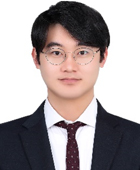
Ph.D. candidate in the Department of Smart Health Science and Technology, Kangwon National University. His research interest is soft robotics.
E-mail: geunsik1124@kangwon.ac.kr
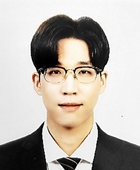
M.S. Student in the Department of Mechanical Convergence Engineering, Kangwon National University. His research interest is 3D LIDAR.
E-mail: rusk@kangwon.ac.kr

Ph.D Student in the Department of Smart Health Science and Technology, Kangwon National University. His research interest is digital twin of machine tool.
E-mail: insik1908@kangwon.ac.kr
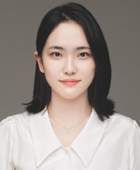
Master of Engineering in the Department of Smart Health Science and Technology, Kangwon National University. Her research interest is Nanobio Engineering.
E-mail: abc@dfg.ac.kr
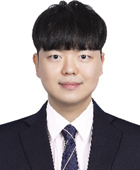
Master of Engineering in the Department of Smart Health Science and Technology, Kangwon National University. His research interest is biotechnology.
E-mail: 202116281@kangwon.ac.kr
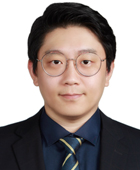
Ph.D in the Department of of Smart Health Science and Technology, Kangwon National University. His research interest is micro/nanoscale surface texturing technologies and the design of medical devices and AI application system design.
E-mail: wkddndrl@kangwon.ac.kr

Assistant professor in the Department of Rehabilitation Medicine, Kangwon National University Medical School His research interests focus on rehabilitation of the aged.
E-mail: hwpark@kangwon.ac.kr
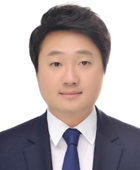
Professor in the Department of Smart Health Science and Technology, Kangwon National University. His research interest is Nanobio Engineering.
E-mail: kimhoman@kangwon.ac.kr
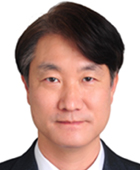
Professor in the Department of Smart Health Science and Technology, Kangwon National University. His research interest is genetic and metabolic engineering.
E-mail: sjha@kangwon.ac.kr

Professor in the Department of Smart Health Science and Technology, Kangwon National University. His research interest is micro and Nano system design and precision control of machine tools the design of medical device and AI application system design.
E-mail: kbh@kangwon.ac.kr

Associate professor in the Department of Smart Health Science and Technology, Kangwon National University. His research interest is soft robots and mechanism design.
E-mail: yjpark@kangwon.ac.kr
